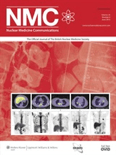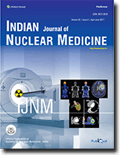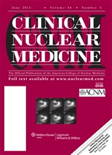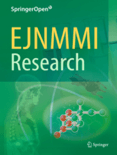
ANNALS OF NUCLEAR MEDICINE
Scope & Guideline
Transforming Understanding through Peer-Reviewed Excellence
Introduction
Aims and Scopes
- Radiopharmaceutical Development:
The journal publishes studies related to the development of new radiopharmaceuticals, including novel tracers for PET and SPECT imaging, highlighting their synthesis, characterization, and clinical applications. - Imaging Techniques and Methodologies:
Research focusing on innovative imaging techniques, including advancements in PET, SPECT, and hybrid imaging modalities like PET/CT and PET/MRI, with an emphasis on improving diagnostic accuracy and patient outcomes. - Clinical Applications and Outcomes:
The journal emphasizes clinical studies that evaluate the effectiveness of nuclear medicine techniques in various medical conditions, including cancer, cardiovascular diseases, and neurological disorders. - Artificial Intelligence and Machine Learning:
Increasingly, the journal features studies that explore the integration of artificial intelligence and machine learning techniques in enhancing image analysis, interpretation, and outcome prediction in nuclear medicine. - Dosimetry and Radiobiology:
Research that investigates radiation dosimetry, pharmacokinetics, and the biological effects of radiopharmaceuticals, contributing to safer and more effective treatment protocols.
Trending and Emerging
- Generative AI and Machine Learning:
An increasing number of papers are focusing on the application of generative AI and machine learning techniques in nuclear medicine, aiming to enhance imaging accuracy, automate image analysis, and improve predictive modeling for patient outcomes. - Personalized Medicine and Theranostics:
There is a growing emphasis on personalized medicine approaches, particularly in the context of theranostics, which combines diagnostic imaging and targeted therapy, especially in cancer treatment. - Advanced Radiotracers for Specific Targets:
The development of novel radiotracers targeting specific biological markers is gaining traction, with studies focusing on their applications in various cancers and other diseases, reflecting a trend towards more targeted imaging. - Impact of COVID-19 on Imaging Practices:
Research examining the effects of COVID-19 on nuclear medicine practices, including changes in imaging protocols and the implications for patient care, has emerged as an important and timely theme. - Integration of Multimodal Imaging Approaches:
There is a trend towards integrating multimodal imaging techniques, combining PET, SPECT, CT, and MRI to provide comprehensive assessments of diseases, enhancing diagnostic capabilities and treatment planning.
Declining or Waning
- Traditional Radiology Techniques:
There is a noticeable decline in studies focusing solely on traditional radiological techniques, as the field shifts towards advanced nuclear imaging modalities that offer more precise diagnostic capabilities. - Conventional Scintigraphy:
Research related to conventional scintigraphy techniques is less frequent, as newer imaging methods and tracers are being developed that provide superior diagnostic information. - Simple Comparative Studies:
The journal has moved away from basic comparative studies without advanced imaging methodologies, reflecting a preference for more complex investigations that incorporate novel technologies and analytical techniques.
Similar Journals

QUARTERLY JOURNAL OF NUCLEAR MEDICINE AND MOLECULAR IMAGING
Fostering Collaboration in the Evolving Landscape of Nuclear Medicine.The Quarterly Journal of Nuclear Medicine and Molecular Imaging, published by Edizioni Minerva Medica in Italy, serves as a pivotal platform for researchers and practitioners in the fields of Nuclear Medicine and Molecular Imaging. With an ISSN of 1824-4785 and an E-ISSN of 1827-1936, this journal boasts a respectable impact factor and is positioned in the Q3 quartile of the Radiology, Nuclear Medicine and Imaging category, based on the latest 2023 evaluations. As the journal continues to converge from its inception in 2004 to its anticipated expansions through 2024, it aims to disseminate high-quality, peer-reviewed articles that advance the frontier of imaging technologies and their applications in clinical practice. Researchers, professionals, and students are encouraged to contribute to its diverse scope, which encompasses innovative research, clinical findings, and reviews that encapsulate cutting-edge advancements in the field, highlighting its importance as an essential resource for knowledge and collaboration.

EUROPEAN JOURNAL OF NUCLEAR MEDICINE AND MOLECULAR IMAGING
Shaping the Future of Diagnostic ImagingThe European Journal of Nuclear Medicine and Molecular Imaging is a prestigious, peer-reviewed journal published by Springer, dedicated to advancing the field of nuclear medicine and molecular imaging. With an impressive impact factor and ranked in the Q1 category for both Medicine and Radiology, Nuclear Medicine and Imaging, this journal is a pivotal platform for researchers and practitioners to disseminate significant findings from 1996 to the present, reflecting the evolution of the field. The journal boasts a notable Scopus rank, standing at #8 out of 333 in its category, placing it in the top 3% of published works, which highlights its critical importance in shaping contemporary practices and research innovations. Although it does not offer an open-access model, the journal provides various access options to ensure that important research is accessible to professionals, students, and academics alike. Through rigorous peer review and a commitment to high-quality publication, the European Journal of Nuclear Medicine and Molecular Imaging plays an essential role in the advancement of nuclear medicine, contributing to better diagnostic and therapeutic outcomes globally.

NUCLEAR MEDICINE COMMUNICATIONS
Connecting Researchers to Revolutionize Patient OutcomesNUCLEAR MEDICINE COMMUNICATIONS is a prestigious academic journal published by Lippincott Williams & Wilkins, focusing on the multifaceted field of nuclear medicine and its applications in diagnostics and therapy. With a solid history spanning from 1980 to 2024, this journal provides a platform for peer-reviewed research articles, clinical studies, and innovative techniques that enrich the knowledge base within the fields of {{medicinal applications, patient care, and imaging technology}}. Currently classified in the Q3 quartile for both Medicine (Miscellaneous) and Radiology, Nuclear Medicine, and Imaging, the journal reflects its commitment to advancing healthcare practices. Although it does not offer open access options, its accessibility through reputable institutions promotes scholarly exchange among researchers, professionals, and students alike. The critical insights provided in NUCLEAR MEDICINE COMMUNICATIONS are essential for those dedicated to enhancing patient outcomes through cutting-edge nuclear medical technologies.

Japanese Journal of Radiology
Exploring Innovations in Imaging and Nuclear MedicineThe Japanese Journal of Radiology, published by SPRINGER, serves as a premier platform for disseminating cutting-edge research and clinical advancements in the fields of radiology, nuclear medicine, and imaging. With an ISSN of 1867-1071 and E-ISSN 1867-108X, this journal has established itself as a vital resource for practitioners, researchers, and students alike. Renowned for its high-quality peer-reviewed articles, it currently enjoys a respectable impact factor within the Q2 category of Scopus rankings, placing it in the 69th percentile among 333 journals in its field. The journal has seen consistent convergence of research from 2009 to 2024, further underscoring its commitment to advancing the understanding of radiological practices. Importantly, the journal offers Open Access options to facilitate widespread dissemination of knowledge, ensuring that vital research reaches its audience without barriers. Addressed in Japan, the Japanese Journal of Radiology plays a critical role in enhancing the global discourse on medical imaging, making it an essential resource for anyone engaged in this dynamic field.

Indian Journal of Nuclear Medicine
Bridging Radiology and Nuclear MedicineIndian Journal of Nuclear Medicine, published by Wolters Kluwer Medknow Publications, serves as a crucial platform for advancing knowledge and research in the field of nuclear medicine, a specialized domain crucial for diagnostic imaging and therapy. With an ISSN of 0972-3919 and an E-ISSN of 0974-0244, this esteemed journal has been a trusted source of information from 2010 to 2024. Situated in Mumbai, India, it caters to researchers and professionals with an interest in the interplay between radiology and innovative nuclear imaging techniques. Although classified as Q4 in Radiology, Nuclear Medicine, and Imaging in 2023, the journal actively contributes to the dialogue surrounding emerging technologies, clinical practices, and challenges in nuclear medicine, making it a significant addition to the academic discourse. While currently not categorized as Open Access, readers can benefit from the wealth of peer-reviewed articles that shape the future of nuclear medicine and its applications. As the impact factor and specific H-index details are not listed, the journal's potential for future growth and increased visibility in the academic community remains promising, positioning it as a commendable resource for students, researchers, and healthcare professionals dedicated to the advancement of medical imaging and therapy.

Molecular Imaging
Illuminating the Future of Biomedical Research.Molecular Imaging is a prominent journal published by SAGE Publications Inc., which serves as a vital platform for the dissemination of high-quality research in the field of molecular imaging. With an E-ISSN of 1536-0121, this journal has established itself within several key areas, including Biomedical Engineering, Biotechnology, Condensed Matter Physics, Molecular Medicine, and Radiology, Nuclear Medicine and Imaging. Spanning from 2002 to 2024 and currently classified within the prestigious Q2 and Q3 quartiles, Molecular Imaging aims to highlight the latest developments and innovative methodologies in molecular imaging techniques and applications. Researchers from diverse backgrounds will find the journal's content valuable for staying updated with recent advancements, evidenced by its competitive Scopus ranking and a commitment to fostering interdisciplinary collaboration. Although the journal is not open access, the rigorous peer-review process ensures that all published articles provide significant contributions to the field, making it an essential resource for professionals, researchers, and students alike.

CLINICAL NUCLEAR MEDICINE
Empowering Innovations in Clinical PracticesCLINICAL NUCLEAR MEDICINE is a premier journal dedicated to the field of nuclear medicine, published by Lippincott Williams & Wilkins. With a history of excellence since its inception in 1978, the journal serves as a vital resource for researchers, healthcare professionals, and students seeking to deepen their understanding of this rapidly evolving discipline. The journal holds a commendable Q2 ranking in both Medicine (miscellaneous) and Radiology, Nuclear Medicine and Imaging, reflecting its significant impact on advancing clinical practices and research. While currently not offered as an open-access publication, CLINICAL NUCLEAR MEDICINE ensures rigorous peer review and high-quality publications, contributing to the broad dissemination of cutting-edge studies and reviews. With its comprehensive scope encompassing both diagnostic and therapeutic nuclear medicine applications, researchers around the globe turn to this journal to stay informed and inspire innovations in patient care for the years leading up to 2024 and beyond.

Nuclear Medicine and Molecular Imaging
Shaping the Future of Radiology through Interdisciplinary CollaborationNuclear Medicine and Molecular Imaging, published by SPRINGER HEIDELBERG, stands as a pivotal platform in the interdisciplinary field of radiology and nuclear medicine, focusing on innovative research and developments from 2010 to 2024. With its ISSN 1869-3474 and E-ISSN 1869-3482, this journal aims to disseminate advanced studies that explore the diagnostic and therapeutic applications of nuclear medicine technologies. Operating from Germany, it has positioned itself in the Q3 category within the Radiology, Nuclear Medicine and Imaging sector, showcasing its relevance among peer journals, with a Scopus rank of #204 out of 333. This journal not only serves as an essential resource for researchers and practitioners eager to stay abreast of modern methodologies and findings but also underscores the crucial advancements in molecular imaging techniques. Although currently not an open-access journal, it doesn't detract from its mission to promote knowledge exchange among academia and the medical community, thus paving the way for innovative solutions and improved patient care in nuclear medicine.

EJNMMI Research
Elevating Standards in Radiology and Nuclear Medicine.EJNMMI Research, a prominent journal published by Springer, plays a pivotal role in advancing the fields of radiology, nuclear medicine, and imaging. With an impact factor that reflects its strong standing—ranking in the top 22% of its category (Q1 as of 2023)—this open-access journal offers researchers, professionals, and students unparalleled access to innovative research and developments in the field since its inception in 2011. Based in Germany, EJNMMI Research fosters global collaboration by ensuring that cutting-edge findings are freely accessible, thereby accelerating scientific discovery and application. With an emphasis on high-quality, peer-reviewed articles, it serves as an essential resource for those seeking to stay at the forefront of nuclear medicine and imaging. By bridging theoretical insights with practical applications, the journal not only influences academic discourse but also supports ongoing advancements in clinical practices.

Chinese Journal of Academic Radiology
Transforming Radiology: Where Knowledge Meets InnovationChinese Journal of Academic Radiology is a leading publication in the field of Radiology, Nuclear Medicine, and Imaging, published by SpringerNature. With an ISSN of 2520-8985 and E-ISSN 2520-8993, the journal aims to bridge the gap between academic research and practical application in radiological sciences. Recognized for its contributions to the advancement of imaging technology and patient care, it currently holds a Q3 quartile ranking for 2023. The journal has a commitment to sharing innovative research findings that address pressing challenges in the field, thereby fostering collaboration and knowledge exchange among researchers, professionals, and students. Although it does not currently offer open access options, the journal's comprehensive reviews and high-quality research articles present a significant resource for those seeking to deepen their understanding of radiological practices and innovations. The Chinese Journal of Academic Radiology continues to play a vital role in shaping the future of radiological science through rigorous scholarship and global discourse.